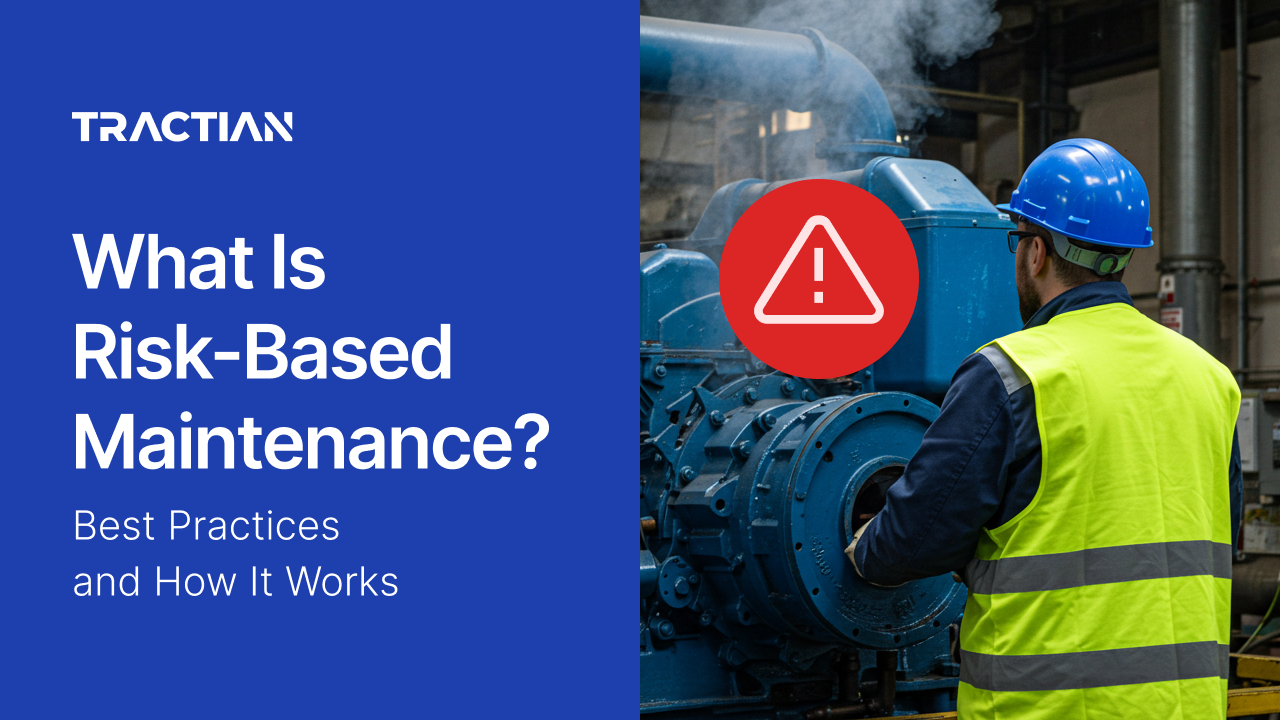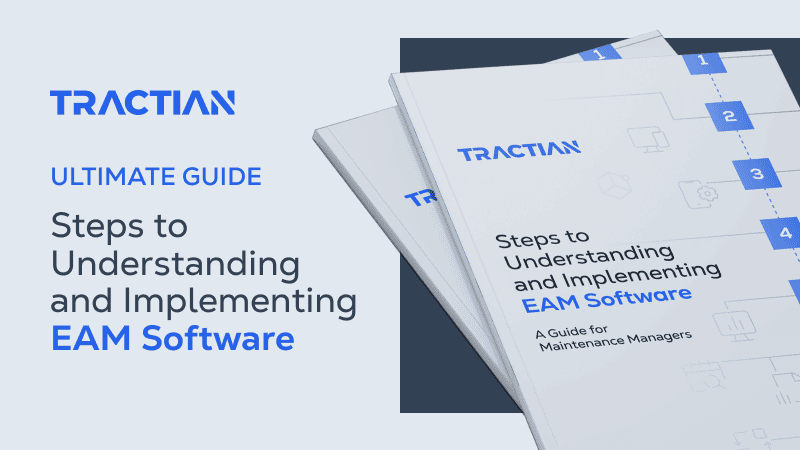Some asset failures can completely derail production. Yet, others can fail with barely anyone noticing. It may seem obvious that not every failure is created equal. But then, why do many teams run a maintenance operation that treats all their assets the same when it comes to planning, strategy, scheduling, and so on?
The truth is, treating all equipment the same is not only a waste of time, but it also compromises reliability and burns through the budget. This is why high-functioning, proactive maintenance teams employ a range of strategies and tools to manage the diverse situations and assets encountered in complex industrial environments.
Risk-based maintenance (RBM) is one of the tools used that helps maintenance teams account for differences in assets. It’s a strategy designed to focus teams on what really matters: preventing failures with the highest operational, safety, or financial impact.
This article explains what RBM is, why it’s a game-changer, and how to apply it in real-world operations.
What Is Risk-Based Maintenance?
Risk-based maintenance prioritizes interventions based on the consequences of failure, not just their frequency. It acknowledges the critical truth that some failures, whether production loss, safety risk, or unplanned costs, hurt more than others.
Instead of running maintenance on a fixed schedule or constantly putting out fires, RBM gives teams a method to focus resources where they move the needle most.
Here’s how it works in practice. RBM evaluates each asset based on two variables: the likelihood of failure and the severity of the potential impact. The formula to calculate RBM is straightforward.
Risk = Probability of Failure × Consequence of Failure
Assets with high risk, either due to frequent issues or catastrophic impact, move to the top of your priority list.
Most teams already operate under pressure, managing hundreds of assets with limited resources. RBM cuts through the noise by helping you allocate time, tools, and attention to the systems that actually keep your plant running. And that shift can make all the difference.
Core Principles of a Risk-Based Approach
Risk-based maintenance works because it forces clarity. You stop treating every machine as equally urgent and start asking a better question: what happens if this equipment fails?
Using this approach, you’re accomplishing more than identifying problems. You’re prioritizing the problems that actually threaten your production, safety, or budget-and likely all three.
Let's examine the RBM methodology more closely.
Risk Assessment
Every asset is evaluated using two key variables: likelihood of failure and severity of consequence. First, let’s point out that this is an evaluation. There’s no reliance on gut feelings. You’re considering the data and factoring in downtime costs, safety risks, environmental impact, and the complexity of potential repairs.
The goal is to build a risk profile that mirrors operational reality.
Criticality Ranking
Once risk is assessed, assets are ranked based on impact. The boiler that feeds your main process line? It’s a priority. A secondary air compressor with minimal load? A lower-tier priority. Ranking in this way becomes your tactical guide for where to focus inspection, maintenance, and monitoring efforts.
Resource Optimization
No team has unlimited bandwidth. RBM helps maintenance leaders put time, budget, and people where they matter most.
Instead of chasing every alert or following rigid PM calendars, you're targeting work that moves the needle.
The outcome? A maintenance plan that reflects the real-world priorities of your operation, not assumptions or habits.
Advantages and Disadvantages of Risk-Based Maintenance
Risk-based maintenance isn’t a silver bullet. However, when done correctly, it’s one of the most effective ways to align maintenance strategy with operational priorities.
Understanding the pros and cons upfront helps you plan better and prepare your team for the transition.
Advantages
The benefits of risk-based maintenance are immediate and measurable, especially in complex operations with limited bandwidth:
- Targeted Resource Allocation: Your team focuses on high-impact assets, not low-priority equipment that won’t cripple operations if it fails.
- Cost Efficiency: You reduce unnecessary checks and replacements on low-risk machinery, freeing up time and budget for what actually matters.
- Improved Safety and Compliance: Equipment with environmental, safety, or regulatory implications gets the attention it deserves, before it becomes a problem.
- Higher Uptime: Prioritizing the assets most likely to disrupt production minimizes unexpected failures and maximizes availability.
- Better Strategic Alignment: Leadership sees clearly where maintenance supports business goals, enabling smarter investment decisions and long-term planning.
Disadvantages
Every strategic shift comes with friction. Risk-based maintenance requires a more deliberate setup, and that means planning for the challenges:
- Initial Complexity: Implementing RBM takes time. Building a solid risk model requires a clear asset inventory and reliable failure data.
- Data Dependency: The system is only as good as the information feeding it. Missing or outdated data can throw off prioritization and lead to blind spots.
- Knowledge Requirements: Effective risk assessment demands a technical understanding of failure modes, impact analysis, and scoring systems. That can mean training or upskilling your team.
- Cultural Resistance: Moving from a fixed calendar to a risk-based workflow can meet pushback. Change management plays a critical role in adoption.
Risk-based maintenance delivers serious value, but it works best when the fundamentals are in place. If your team has reliable data, cross-functional support, and a clear maintenance plan, the benefits are substantial.
Steps to Implement Risk-Based Maintenance
Risk-based maintenance isn’t something you switch on overnight. It’s a process that evolves in tandem with your team, data, and operations. What matters is building a culture that is risk-aware. One that knows which assets drive performance and which just take up space.
Here’s an outline of the steps needed to get started developing a Risk-Based Maintenance:
1. Assess Critical Assets
Start by mapping the entire landscape. Build a comprehensive inventory of equipment, encompassing both core production lines and auxiliary systems. Then evaluate each one across five key dimensions:
- Personnel safety risks
- Impact on production if it fails
- Environmental or regulatory exposure
- Replacement cost and lead time
- Failure frequency and historical behavior
This step sets the baseline, so don’t think of it as just a list of assets. What you’re doing is identifying which ones are essential to uptime, safety, and cost control. And this is what becomes your initial risk profile.
2. Evaluate Likelihood and Consequences
Next, you need to quantify the risk. For every asset, form an estimation regarding the two core variables of RBM we discussed at the beginning:
- Likelihood of failure: Based on asset condition, operational load, maintenance history, and age.
- Impact Severity of failure: From minor performance dips to full-scale shutdowns or safety violations.
A structured tool like FMEA (Failure Mode and Effects Analysis) can be particularly helpful in this context. It doesn’t need to be perfect, especially in the early stages. What matters is applying the same logic consistently across your assets, ensuring your results are comparable and actionable.
3. Prioritize and Schedule
Once you’ve scored asset risk, it’s time to act on it. Use those scores to build a clear maintenance priority matrix. High-risk assets are prioritized at the top of the schedule, receiving more frequent and in-depth inspections and condition monitoring. For the low-risk assets, they might be fine with routine checks or even a run-to-failure plan.
Reaching this point marks a significant shift in your operational strategy. Your maintenance calendar stops being a generic rotation based on OEM guidelines. Instead, it reflects the reality of your maintenance environment based on risk, performance history, and operational impact.
4. Monitor and Adjust
Risk-based maintenance isn’t a one-and-done process. Assets evolve, production cycles shift, and failure modes emerge over time, which is why regular review is essential.
Set a quarterly review cadence for your risk assessments or update immediately after major incidents or operational changes. Use it to refresh priorities and adjust frequencies as needed. The more dynamic your approach, the more value you’ll unlock.
“We started by focusing on our most critical production line. Within three months, we’d reduced emergency repairs by 40% just by redirecting resources based on risk. Now we’ve rolled it out plant-wide, and our overall downtime is the lowest it’s been in five years.” - Maintenance Manager, Midwestern Chemical Plant
[Read the full case study here]
Risk-Based Asset Management Tools and Techniques
A risk-based strategy is only as strong as the data behind it. If you’re guessing, you’re not managing risk. You’re reacting to its appearance, which is often too late. At this point, it’s no longer a risk, but reality. However, the right tools turn risk-based maintenance from theory into execution.
Let’s look at current RBM frameworks and the three pillars they typically rely on.
1. Data Collection Systems
Knowing asset conditions in real time makes defining risks way easier. Condition monitoring tools like vibration sensors, thermal monitors, and oil analysis systems help you track wear, detect anomalies, and estimate failure likelihood before problems escalate.
2. Risk Assessment Software
Spreadsheets can’t keep up with dynamic environments. Proactive, action-oriented platforms help you build and update risk matrices, log failure history, and visualize asset criticality over time. These tools support decision-making and make prioritization transparent across teams.
3. Analytical Techniques
As your system matures, analysis becomes your edge. Root cause analysis, trend detection, and structured reviews of historical failures help refine your risk model. You start seeing not just what failed, but why, and how to prevent it next time.
The right combination of tools depends on your industry and equipment types. A food processing plant may focus more on sanitation and contamination risks, while a heavy manufacturing operation may prioritize mechanical failures and safety hazards.
Key Performance Indicators to Track
If your risk-based maintenance strategy is effective, the data will reflect it. Tracking the right metrics not only validates your approach, it also helps fine-tune it as conditions evolve.
Watch these core indicators to determine if your efforts are having the impact you need:

1. Mean Time Between Failures (MTBF)
MTBF indicates how long critical assets operate before experiencing a failure. A well-executed RBM strategy should increase MTBF, especially for top-priority assets. Break it down by equipment class to identify improvement trends or outliers that need deeper investigation.
2. Unplanned Downtime Costs
Track the total cost of reactive events: production loss, emergency labor, rush shipping, and unplanned repairs. If your risk assessments are accurate and well-implemented, this number should drop steadily. It's one of the clearest indicators of whether your prioritization is paying off.
3. Failure Frequency
Monitor the frequency of equipment breakdowns, particularly in high-risk categories. Over time, you should see fewer failures in your most critical systems. If not, it’s a sign your risk scoring or execution needs adjustment.
Additional Metrics to Monitor
- Work order backlog by risk level: Helps track whether high-risk work is getting completed on time.
- Maintenance cost per asset class: Reveals if your resource allocation aligns with asset value and risk.
- PM compliance on critical assets: Ensures preventive work is consistently happening where it matters most.
What matters most is that your KPIs tie directly back to risk. If you're tracking the right numbers, they’ll show whether your team is working smarter, not just harder.
Common Challenges and How to Solve Them
Even well-planned maintenance strategies run into friction. Risk-based maintenance is no exception. But most challenges are manageable, especially if you anticipate them early and respond with focused action.
Insufficient Asset Data
Solution: Start where the risk is highest.
You don’t need a complete dataset to begin. Focus on your most critical systems first. Document failure modes, repair history, and operating conditions. As you build confidence and data volume, scale the approach across less critical assets.
Resistance to Methodology Change
Solution: Lead with results, not theory.
When your RBM program prevents a costly failure or reduces emergency downtime, share the outcome. Quantify the impact as dollars saved, hours gained, or production stabilized. Real examples cut through skepticism and get teams on board.
Budget Constraints
Solution: Build in layers.
There’s no need to overhaul everything at once. Use existing PMs and inspections to gather risk data. Layer in condition monitoring or risk-scoring tools over time. Show early ROI, then reinvest in expanding your capabilities.
Bonus Reminder: You don’t need a perfect rollout to start reaping the benefits. The biggest wins in risk-based maintenance often come from shifting focus, putting resources toward high-risk areas, even with limited data. Start smart. Prove value early. Then build from there.
The Smarter Way to Manage Maintenance Risk
Risk-based maintenance represents a shift in how industrial teams think about asset management. By prioritizing work based on actual operational risk, teams stop reacting to failures and start preventing the ones that matter most.
But there’s a catch: most maintenance teams are already stretched thin. They’re managing outdated spreadsheets, juggling emergency work orders, and trying to make decisions with incomplete data. This situation is precisely why most risk-based programs stall. They can’t even make changes because they’re barely staying afloat.
Fortunately, there’s good news for teams in such a position. Tractian’s CMMS can change it. It centralizes your asset history, automates work order prioritization based on risk, and gives your team visibility into what’s critical, without adding complexity. You get a structured framework that supports a risk-based approach from day one.
With built-in analytics and automated reporting, you get visibility into trends, recurring failure patterns, and long-term asset performance. With this, you’re not just preventing breakdowns, you’re building a smarter, more resilient operation over time.
But, it gets better. With Tractian’s platform, you can tie real-time sensor data directly into your CMMS. That means your risk insights don’t just come from past failures, they can evolve with live asset conditions, giving your team a predictive edge. By simply adopting Tractian’s CMMS, you’ll automatically be positioned to transition to a proactive maintenance operation.
Additionally, Tractian gets you started with a free onboarding process and a quick implementation.



